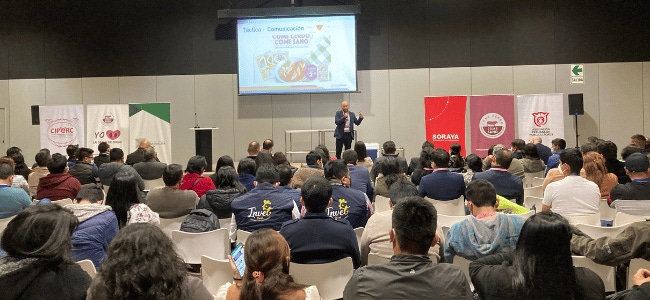Thaler provided an explanation of the nutritional characteristics of DDGS, while Stein focused on the importance of calcium, phosphorus and phytase in weaning.
July 27, 2022

To increase awareness of distiller's dried grains with solubles usage in Peruvian swine diets and strengthen ties with the pork sector, the U.S. Grains Council sponsored four speakers at the annual International Pork Congress organized by the Peruvian Pork Association.
The event provided updated information on swine health, production, feed manufacturing, nutrition, marketing and challenges and innovations faced by the sector worldwide. Half the 500 attendees were Peruvian pork producers.
"The pork industry in Peru grows every year, recently at higher rates than poultry production. Even though the sector was impacted first by the pandemic and most recently by higher input prices, its story of resilience is a sign of a tireless job done year after year by producers and their industry association ASOPORCI," says Ana Ballesteros, USGC marketing director in Latin America. "In the association, the council found a strategic ally. Supporting its efforts to continue developing the industry has the double benefit of reinforcing our relationship with it and contributing to its growth and, therefore, feed grains demand."
Robert Thaler from South Dakota State University spoke on behalf of the council during the first day of programming. Thaler provided participants with an explanation of the nutritional characteristics of DDGS, recommended inclusion rates and potential benefits of including DDGS in swine formulas. That same day, Colombian nutritionist Sebastian Montoya presented the economic benefits of harvesting at higher carcass weights. This topic has been part of the council's focus in the region for the pork sector. Besides improving financial results for producers in most markets, it also implies higher feed consumption and, therefore, higher feed grains demand.
Also, the council's regional consultant, Carlos Maya, former executive director of the Colombian pork producers association, discussed with the participants the role that professionally-managed industry associations and consumption-oriented campaigns can play in supporting the sector's growth.
The next day, Hans Stein of the University of Illinois updated participants on the nutritional considerations for weaning-stage pigs. Stein primarily focused on the importance of calcium, phosphorus and phytase in this phase of a pig's life cycle.
"Different speakers and topics were relevant to accomplishing our goals and those of the association. The speakers provided important information for the development and general performance of the industry and promoted the use of DDGS and feed grains," Ballesteros says.
According to ASOPORCI, pork production in Lima grew 4.5% in 2021. Growth for 2022 is expected to be around 5%, and the association has an ongoing campaign to increase per-capita consumption in the country. Peruvians consume 9.4 kilograms (kg) (20.72 pounds) of pork per person each year. The goal is to reach 12 kg (26.45 pounds) by 2024; the South American average consumption is currently around this level.
As consumption continues to grow, increased production by professionalized operations will be necessary. There will also be greater incentive to become an industrial producer, providing an opportunity for higher feed grains demand by the sector in the mid- and long-term.
The council looks forward to continuing its support of the Peruvian pork industry's efforts to increase pork consumption, contribute to the sector's efficiency and increase awareness of DDGS usage in swine diets.
Source: U.S. Grains Council, which is solely responsible for the information provided, and wholly owns the information. Informa Business Media and all its subsidiaries are not responsible for any of the content contained in this information asset.
You May Also Like



